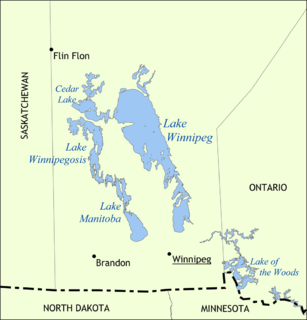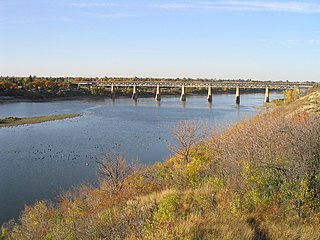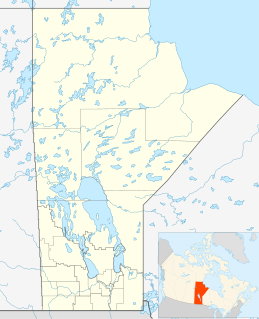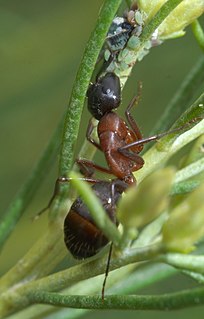
The University of Manitoba is a non-denominational, public research university in the province of Manitoba, Canada. Founded in 1877, it is the first university of western Canada.

Lake Winnipeg is a very large, relatively shallow 24,514-square-kilometre (9,465 sq mi) lake in North America, in the province of Manitoba, Canada. Its southern end is about 55 kilometres (34 mi) north of the city of Winnipeg. Lake Winnipeg is Canada's sixth-largest freshwater lake and the third-largest freshwater lake contained entirely within Canada, but it is relatively shallow excluding a narrow 36 m (118 ft) deep channel between the northern and southern basins. It is the eleventh-largest freshwater lake on Earth. The lake's east side has pristine boreal forests and rivers that were in 2018 inscribed as Pimachiowin Aki UNESCO World Heritage Site. The lake is 416 km (258 mi) from north to south, with remote sandy beaches, large limestone cliffs, and many bat caves in some areas. Manitoba Hydro uses the lake as one of the largest reservoirs in the world. There are many islands, most of them undeveloped.

Lake Manitoba is the 14th largest lake in Canada and the 33rd largest lake in the world with a total area of 4,624 square kilometres (1,785 sq mi). It is located within the Canadian province of Manitoba about 75 kilometres (47 mi) northwest of the province's capital, Winnipeg, at 51°0′N98°45′W.

The Saskatchewan River is a major river in Canada, about 550 kilometres (340 mi) long, flowing roughly eastward across Saskatchewan and Manitoba to empty into Lake Winnipeg. Through its tributaries the North Saskatchewan and South Saskatchewan, its watershed encompasses much of the prairie regions of central Canada, stretching westward to the Rocky Mountains in Alberta and northwestern Montana in the United States. It reaches 1,939 kilometres (1,205 mi) to its farthest headwaters on the Bow River, a tributary of the South Saskatchewan in Alberta.

The zebra mussel is a small freshwater mussel. The species was originally native to the lakes of southern Russia and Ukraine, but has been accidentally introduced to numerous other areas and has become an invasive species in many countries worldwide. Since the 1980s, the species has invaded the Great Lakes, Hudson River, and Lake Travis.
Bell MTS Inc. is a subsidiary of BCE Inc. that operates telecommunications services in the Canadian province of Manitoba. The company's head office is located in MTS Place at 333 Main Street, in Downtown Winnipeg, Manitoba.

Thompson is a provincial electoral division in the Canadian province of Manitoba. It was created by redistribution in 1968 from parts of Churchill and Rupertsland, and has formally existed since the provincial election of 1969.

Reindeer Lake is a lake in Western Canada located on the border between northeastern Saskatchewan and northwestern Manitoba, with the majority in Saskatchewan. The name of the lake appears to be a translation of the Algonquian name. It is the 24th largest lake in the world by area, as well as being the second-largest lake in Saskatchewan and the ninth largest in Canada. 8% of the lake lies in Manitoba and 92% of lake in Saskatchewan.

Birds Hill Provincial Park is a provincial park in Manitoba, Canada located in the Boreal Plains ecozone. The park protects areas representative of Aspen/Oak parkland, as well as provides opportunities for recreation. It is located 24 kilometres north of Winnipeg on Highway 59, and covers approximately 8,300 acres or 35.1 km2.
Highway 994 is a provincial highway in the far north region of the Canadian province of Saskatchewan. One of the province's shortest highways, it is approximately 1.1 kilometres (0.68 mi) long. Highway 994 provides access to the isolated community of Kinoosao. Due to its geographic location, it is the only provincial highway in Saskatchewan that requires entering the neighboring province of Manitoba to travel it. The route begins at the shores of Reindeer Lake in Kinoosao and heads eastward a short distance to the provincial line, where it continues eastward as Manitoba Provincial Road 394 towards Lynn Lake, Manitoba.

The Province of Manitoba, similar to other Canadian provinces and territories, is governed through a Westminster-based parliamentary system. The Manitoba government's authority to conduct provincial affairs is derived from the Constitution of Canada, which divides legislative powers among the federal parliament and the provincial legislatures.
The school leaving age is the minimum age a person is legally allowed to cease attendance at an institute of compulsory secondary education. Most countries have their school leaving age set the same as their minimum full-time employment age, thus allowing smooth transition from education into employment, whilst a few have it set just below the age at which a person is allowed to be employed.

The Capniidae, the small winter stoneflies, are a family of insects in the stonefly order (Plecoptera). It constitutes one of the largest stonefly families, containing some 300 species distributed throughout the holarctic. Their closest relatives are the rolled-winged stoneflies (Leuctridae).

Camponotus vicinus is a species of ant in the subfamily formicinae. C. vicinus is widespread throughout western North America, from Alaska, south to Mexico, and east to Texas and Manitoba. Unlike its wood nesting "carpenter ant" relatives, Camponotus vicinus is typically found nesting in the soil under stones and other objects. The giant ants in the 1954 film Them! are identified as C. vicinus, despite multiple anatomical differences, including the presence of a sting, which is absent in Formicine ants.
Emblyna manitoba is a species of mesh web weaver in the spider family Dictynidae. It is found in the United States and Canada.
Capnura is a genus of small winter stoneflies in the family Capniidae. There are about seven described species in Capnura.
Anisota manitobensis, the Manitoba oakworm moth, is a species of royal moth in the family Saturniidae. It is found in North America.
The 43rd Manitoba general election is scheduled to occur on or before 2023 to elect members to the Legislative Assembly of Manitoba. The incumbent Progressive Conservatives will attempt to retain the majority they won in the 2019 election.

Martin B. Morantz is a Canadian lawyer, businessperson, philanthropist and politician from Winnipeg. He was elected to represent the riding of Charleswood—St. James—Assiniboia—Headingley in the House of Commons of Canada as their Member of Parliament in the 2019 Canadian Federal Election. Morantz ran as the Conservative candidate, unseating Liberal incumbent Doug Eyolfson in the riding.











